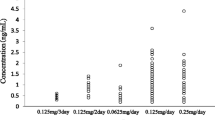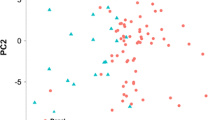Summary
Phenazone (antipyrine) 1g was given by short intravenous infusion to 62 study participants (10 healthy drug-free volunteers and 52 patients with chronic liver disease). A Bayesian approach was developed to determine the individual pharmacokinetic parameters of Phenazone.
Statistical characteristics of the population pharmacokinetic parameters were first evaluated for 30 patients. When combined with 1 plasma drug concentration from members of the second group, these led to a Bayesian estimation of individual pharmacokinetic parameters for the remaining 32 individuals. Total clearance computed by Bayesian estimation was compared with maximal likelihood estimation of this parameter, the classical procedure. No statistically significant differences were found. Performance of the developed methodology was evaluated by computing bias and precision. The mean error was 0.0477 L/h. The precision of the prediction of this parameter (0.155 L/h) remained lower than the interindividual standard deviation (0.765 L/h).
This procedure enables the estimation of individual pharmacokinetic parameters for Phenazone. In this study, numerous laboratory tests were performed. A highly significant correlation (p < 0.001) was found between Phenazone clearance and the prothrombin time, albumin, γ-globulin, factor V, antithrombin III, fibrinogen and total bilirubin. Discriminant analysis determined that protein, alkaline phosphatase, creatininaemia and γ-globulin had more significant discriminating power and gave better prognostic results than those seen with the Child-Pugh test.
Similar content being viewed by others
References
Albers I, Hartmann H, Bircher J, Creutzfeldt W. Superiority of the Child-Pugh classification to quantitative liver function tests for assessing prognosis of liver cirrhosis. Scandinavian Journal of Gastroenterology 24: 269–276, 1989
Branch RA. Drugs as indicators of hepatic function. Hepatology 2: 97–105, 1982
Branch RA, Herbert CM, Read AE. Determinants of serum anti-pyrine half-lives in patients with liver disease. Gut 14: 569–573, 1973
Branch RA, James JA, Read AE. The clearance of antipyrine and indocyanine green in normal subjects and in patients with chronic liver disease. Clinical Pharmacology and Therapeutics 20: 81–89, 1976
Branch RA, Shand DG, Wilkinson GR, Nies AS. Increased clearance of antipyrine and d-propranolol after phénobarbital treatment in the monkey: relative contributions of enzyme induction and increased hepatic blood flow. Journal of Clinical Investigation 53: 1101–1107, 1974
Bressolle F, Ray P, Jacquet JM, Bres J, Galtier M, et al. Bayesian estimation of doxorubicin pharmacokinetic parameters. Cancer Chemotherapy and Pharmacology 29: 53–60, 1991
Brodie BB, Axelrod J. The fate of antipyrine in man. Journal of Pharmacology and Experimental Therapeutics 98: 97–104, 1950
Burton ME, Brater DC, Chen PS, Day RB, Huber PJ, et al. A Bayesian feedback method of aminoglycoside dosing. Clinical Pharmacology and Therapeutics 37: 349–357, 1985
Chopra S, Griffin PH. Laboratory tests and diagnostic procedures in evaluation of liver disease. American Journal of Medicine 79: 221–230, 1985
Corless JK, Middleton HM. Normal liver function: a basic for understanding hepatic disease. Archives of Internal Medicine 143: 2291–2294, 1983
Danhof M, Groot Van Der Vis E, Breimer DD. Assay of anti-pyrine and its primary metabolites in plasma saliva and urine by high performance liquid chromatography and some preliminary results in man. Pharmacology 18: 210–223, 1979
Danhof M, Teunissen MWE. Antipyrine as a model drug to assess oxidative drug metabolizing in man. Pharmacy International 5: 11–15, 1984
Dossing M, Poulsen HE, Andreasen PB, Tygstrup N. A simple method for determination of antipyrine clearance. Clinical Pharmacology and Therapeutics 32: 392–396, 1982
Dossing M, Volund A, Poulsen HE. Optimal sampling times for minimum variance of clearance determination. British Journal of Cünical Pharmacology 15: 231–235, 1983
Farrell GC, Cooksley WGE, Powell LW, Hart P. Interaction between liver disease and chronic drug investigation on hepatic metabolism. Abstract. Gastroenterology 71: 905, 1976
Farrell GC, Cooksley WGE, Hart P, Powell LW. Drug metabolism in liver disease: identification of patients with impaired hepatic drug metabolism. Gastroenterology 75: 580–588, 1978
Garraffo R, Iliadis A, Cano JP, Dellamonica P, Lapalus P. Application of Bayesian estimations for the prediction of an appropriate dosage regimen of amikacin. Journal of Pharmaceutical Sciences 78: 753–757, 1989
Goldberg DM, Brown D. Advances in the application of biochemical tests to diseases of the liver and biliary tract: their role in diagnosis, prognosis and the elucidation of pathogenetic mechanisms. Clinical Biochemistry 20: 127–148, 1987
Hurley FS, McNeil JJ. A comparison of a least squares regression, a Bayesian, Chiou’s and the steady-state clearance method of individualizing theophylline dosage. Clinical Pharmacokinetics 5: 311–320, 1988
Iliadis A, Bachir-Rabo M, Bruno R, Favre R. Bayesian estimation and prediction of clearance in high-dose methotrexate infusion. Journal of Pharmacokinetics and Biopharmaceutics 13: 101–115, 1985
Iliadis A. Le logiciel APIS: adaptation de posologie, identification et simulation en pharmacocinétique clinique, pp. 100–111, Journées d’Informatique Médicale de Montpellier, Sauramps Médical, Inc., Montpellier, 1988
Krausz Y, Zylber-Katz E, Levy M. Antipyrine clearance and its correlation to routine liver function tests in patients with liver disease. International Journal of Clinical Pharmacology Therapy and Toxicology 18: 253–257, 1980
Leevy CM, Tygstrup N (Eds) Standardization of nomenclature, diagnostic criteria and diagnostic methodology for diseases of the liver and biliary tract, Karger, Basel, 1976
McPherson GAD, Benjamin IS, Boobis AR, Brodie MJ, Hampden C, et al. Antipyrine elimination as a dynamic test of hepatic functional integrity in obstructive jaundice. Gut 23: 734–738, 1982
Meffin PJ, Williams RL, Blaschke TF, Rowland M. Application of salivary concentration data to pharmacokinetic studies with antipyrine. Journal of Pharmaceutical Sciences 66: 135–137, 1977
Miguet JP, Allemand H, Joanne C, Dhumeaux D. La clairance de l’antipyrine: un test pour apprécier la fonction hépatique d’oxydation des médicaments: étude au cours de la cirrhose. Nouvelle Presse Médicale 7: 4209–4211, 1978
Miguet JP, Vuitton D, Deschamps JP, Allemand H, Joanne C, et al. Cholestasis and hepatic drug metabolism: comparison of metabolic clearance rate of antipyrine in patients with intrahepatic or extrahepatic cholestasis. Digestive Diseases and Sciences 26: 718–722, 1981
Nöda S, Kawaka S, Miyoshi S, Minami Y, Tarui S. Antipyrine clearance per unit liver volume in cirrhosis with and without hepatocellular carcinoma indicating a correlation with histological change of the liver. Gastroenterologia Japonica 24: 159–163, 1989
Orrego H, Israel Y, Blake JE, Medline A. Assessment of prognostic factors in alcoholic liver disease: toward a global quantitative expression of severity. Hepatology 3: 896–905, 1983
Roberts CJ, Jackson L, Halliwell M, Branch RA. The relationship between liver volume, antipyrine clearance and indocyanine green clearance before and after phenobarbitone administration in man. British Journal of Clinical Pharmacology 3: 907–913, 1976
Sheiner LB. Analysis of pharmacokinetic data using parametric models II: point estimates of an individual’s parameters. Journal of Pharmacokinetics and Biopharmaceutics 13: 515–540, 1985
Sheiner LB, Beal SL. Some suggestions for measuring predictive performance. Journal of Pharmacokinetics and Biopharmaceutics 9: 503–512, 1981a
Sheiner LB, Beal SL. Evaluation of methods for estimating population pharmacokinetic parameters II: biexponential model and experimental pharmacokinetic data. Journal of Pharmacokinetics and Biopharmaceutics 9: 635–651, 1981b
Sheiner LB, Beal SL. Pharmacokinetic parameter estimates from several least squares procedures: superiority of extended least squares. Journal of Pharmacokinetics and Biopharmaceutics 13: 185–201, 1985
Sheiner LB, Halkin H, Peck C, Rosenberg B, Melmon KL. Improved computer-assisted digoxin therapy: a method using feedback of measured serum digoxin concentration. Annals of Internal Médecine 82: 619–627, 1975
Sheiner LB, Rosenberg B, Melmon KL. Modelling of individual pharmacokinetic for computer-aided drug dosage. Computers and Biomedical Research 5: 411–459, 1972
Sotaniemi EA, Pelkonen RO, Mokka RE, Huttunen R, Viljakainen E. Impairment of drug metabolism in patients with liver cancer. European Journal of Clinical Investigation 7: 269–274, 1977
Vessell ES. The antipyrine test in clinical pharmacology: conceptions and misconceptions. Clinical Pharmacology and Therapeutics 26: 275–286, 1979
Villeneuve JP, Arsene D, Huet PM. Assessment of liver function by the aminopyrine breath-test. Clinical and Investigative Medicine 6: 5–9, 1983
Vozeh S, Muir KT, Follath F, Sheiner LB. Predicting individual Phenytoin dosage. Journal of Pharmacokinetics and Biopharmaceutics 9: 131–146, 1981
Williams SJ, Farrell GC. Serial clearance studies detect altered hepatic metabolic function during spontaneous and interferon-induced changes in chronic hepatitis B disease activity. Hepatology 10: 192–197, 1989
Author information
Authors and Affiliations
Rights and permissions
About this article
Cite this article
Fabre, D., Bressolle, F., Goméni, R. et al. Identification of Patients with Impaired Hepatic Drug Metabolism Using a Limited Sampling Procedure for Estimation of Phenazone (Antipyrine) Pharmacokinetic Parameters. Clin. Pharmacokinet. 24, 333–343 (1993). https://doi.org/10.2165/00003088-199324040-00006
Published:
Issue Date:
DOI: https://doi.org/10.2165/00003088-199324040-00006




